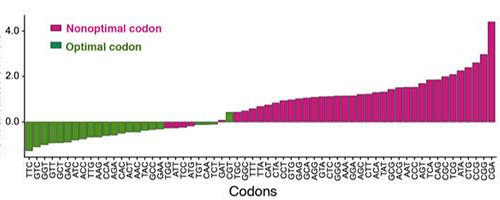by University of Science and Technology of China Rapidly increasing cancer incidence and mortality worldwide have raised great challenges for the currently available anticancer options, which warrants the development of new therapeutic modalities based on novel antitumor mechanisms. Ferroptosis, a recently discovered form of non-apoptotic cell death, is one such candidate and has already demonstrated...
Tag: <span>DNA</span>
Defects in the ‘Swiss-army knife’ of gene expression may contribute to neuronal diseases like Alzheimer’s
The growth, death, and diseases of complex organisms rely on the flow of information — from genes in DNA, through their transcription into RNA, and then translation of that transcript into proteins, which in turn build much of the living organism. Proteins that control this whole process are themselves subject to this overarching information flow...
All Your Memories Are Stored by One Weird, Ancient Molecule
Credit: Christoph Burgstedt / Science Photo Library / Getty Images. How does memory work? The further we seem to dive in, the more questions we stumble upon about how the function of memory first evolved. Scientists made a key breakthrough with the identification of the Arc protein in 1995, observing how its role in the...
TGF-β-driven reduction of CYGB is associated with oxidative DNA damage of HSCs in NASH
In the 2020 April 21 issue of Journal of Hepatology, a research group from the Department of Hepatology in Osaka City University Graduate School of Medicine, Japan reported that a new insight into the pathophysiology of human nonalcoholic steatohepatitis (NASH) with fibrosis and suggested a possibility of the new therapy using cytoglobin (CYGB) inducer for...
Milestone for the early detection of sepsis
By: LUNGHAMMER – TU GRAZ Whether activating or silencing genes, breaking down defective cells or building new tissue, our body is constantly working to repair itself, even in cases of illness. To fight a disease, our body sends out signals, often long before we ourselves notice the disease. Such signals are, for example, DNA molecules...
CRISPR helps identify potential Alzheimer’s-related protein
by University of Tokyo Experts at the University of Tokyo have identified a new protein in the pathway that leads to Alzheimer’s disease. Researchers used the “molecular scissors” of CRISPR/Cas9 to search for new genes related to the neurodegenerative disease. The exact causes of Alzheimer’s disease remain unknown, but one of the most well-supported theories...
Scientists reveal how proteins team up to repair DNA
New insight on DNA repair in yeast adds to our understanding of why DNA repair processes fail to function properly in disease ELIFE Scientists have revealed an important mechanism in the repair of DNA double-strand breaks, according to new research published today in eLife. The discovery will help our understanding of why DNA repair processes...
Huntington’s disease-causing DNA repeat mutations reversed in the lab
Neurodegenerative diseases, like Huntington’s disease and myotonic dystrophy, are often referred to as DNA repeat diseases, named because of long repeated sequences in the DNA of patients. Increasing repeat expansion length in the affected tissues contribute to earlier age of disease onset and worsen the progression and severity of the disease over time. Graphic portrays...
Jumping genes’ help stabilize DNA folding patterns
Long understood as source of novel genetic traits, jumping genes also provide genomic stability WASHINGTON UNIVERSITY SCHOOL OF MEDICINE “Jumping genes” — bits of DNA that can move from one spot in the genome to another — are well-known for increasing genetic diversity over the long course of evolution. Now, new research at Washington University...
Know thy mitochondria: Autoimmunity to organelles and their DNA
by John Hewitt , Medical Xpress The immune system uses its mitochondria to self-stimulate innate and adaptive responses to infection. Reactive oxygen species (ROS), immunogenic mitochondrial DNA (mtDNA), and even whole mitochondria are locally mobilized in a delicate balance to create hot spots of inflammatory action. When normal limiting feedback on these processes is compromised,...






